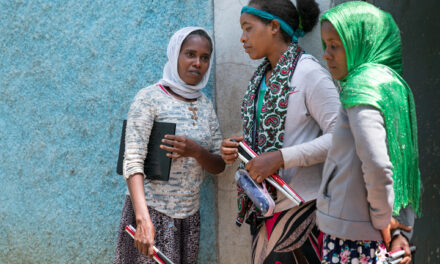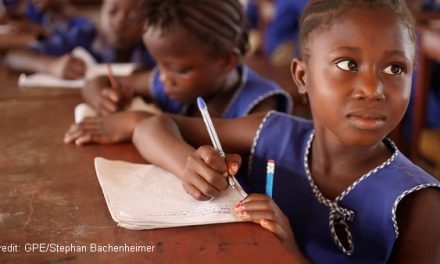This blog was written by Pauline Rose, REAL Centre at the University of Cambridge, Monazza Aslam and Shenila Rawal, Oxford Partnership for Education Research and Analysis (OPERA).
Over the past six years, we have had the pleasure to collaborate on evaluation studies for the Girls’ Education Challenge, in partnership with colleagues from Tetra Tech and Fab Inc. As the Girls’ Education Challenge (GEC) has now come to an end after 12 years, reaching over 1.6 million girls, we reflect on the evidence generated through the studies that we have led on.
Our journey began with the development of a research feasibility study for the GEC, identifying gaps related to six themes that GEC evidence could help fill. Our approach in the independent evaluation has stressed the importance of adopting an approach that was concerned with learning for programme improvement as well as wider learning for global education. This has involved close engagement with the fund manager, who was responsible for the overall implementation of the programme, implementing partners for 41 projects across the 17 countries of the GEC, as well as researchers and practitioners in each of the countries where more detailed studies were undertaken.
The shift from considering evaluations as purely for accountability purposes (using them for identifying outcomes on which payments would be made), to ones for learning and feedback, is increasingly recognised as relevant and legitimate. The recently-established What Works Hub for Global Education’s implementation science research approach is an example of this.
In this blog, we highlight lessons from the independent evaluation studies we led on according to the six themes that were identified in the GEC research feasibility study:
- Gender-sensitive pedagogy
In our study on ‘Teachers and Teaching for Marginalised Girls’, we identified that teachers supported by GEC projects applied learner-centred pedagogies, gender-equal practices and gender-related content in their classes to engage marginalised girls. Teacher training contributed to this change as well as improving self-confidence in teaching, gender responsiveness, and awareness about child protection and safeguarding. These learner-centred, inclusive and gender-responsive pedagogies require enhanced support for implementation, given the resource-constrained environments in which many teachers work.
This study was undertaken during the Covid-19 pandemic. It found that female community-based teachers were instrumental in supporting girls’ ongoing engagement with learning, sustaining their motivation, and reducing their risk of dropping out of school. In government education systems, where teachers were not always able to contact learners outside of formal school settings, community-based models facilitated home-based and phone-based learning and wellbeing support. The role of female educators was particularly important as safeguarding concerns affected the extent to which male educators could provide support to girls outside the classrooms.
- Physical and mental health
In the study on ‘Teachers and Teaching’, we found that Covid-19 impacted not only girls’ learning but also their mental health – with higher levels of anxiety during school closures. Community-based female teachers were trusted sources of information for girls and communities, providing critical health, safety, and wellbeing information and pastoral support. Some projects adapted their training to support teachers in these additional responsibilities but often they were not adequately equipped for this. In addition, their own wellbeing was often overlooked.
The provision of hygiene and dignity kits for adolescent girls, alongside menstrual hygiene management information during life-skills sessions, were identified as particularly important in mitigating barriers to attending learning centres of the Leave No Girl Behind (LNGB) projects in the study on ‘Education Pathways for Marginalised Adolescent Girls Beyond Formal Schooling’.
- Social norm change
In this study on Alternative Pathways, girls in the three LNGB case study projects identified that their engagement in decision-making had enhanced due to greater confidence related to improvements in literacy, numeracy and life skills. Adolescent girls who were unmarried, without children, or did not report a disability were more likely to feel that their decision-making capabilities had increased, especially among older girls.
Girls reported being more ambitious in their aspirations. Being part of the project allowed them to nurture higher aspirations for the future that they previously did not have. They were also more likely to make decisions about their day-to-day lives, such as household expenditures or visiting the market, health clinic or friends. A smaller proportion were able to make longer-term, more fundamental decisions about education, marriage, and income-generating activities. However their husbands or other family members retained decision-making powers over these activities.
In the study on Alternative Pathways ,as well as the upcoming study on ‘Sustaining Changes in Community Attitudes and Norms to Improve Girls’ Education Outcomes’, we find that engaging ‘change champions’, such as religious leaders and village heads within communities ensures that changes in harmful practices (e.g. those associated with early marriage, early pregnancy, and gender-based violence) are sustained. In addition, providing training to groups such as school management committees and mothers’ groups also helps to sustain change. (
- Transitions within and beyond education
Gender social norms are a key factor in determining girls’ transitions within and beyond education. As shown in the study on Alternative Pathways, girls’ choices of transition pathways were often constrained by their age. Younger adolescents could often only be offered formal schooling, due to national labour laws. In contrast, older girls were often only offered skills or work-related opportunities.
Girls on skills or work-related pathways tended to concentrate in a narrow range of sectors, often those traditionally associated with women, such as hairdressing and tailoring. This led to some girls attempting to launch businesses in already saturated markets. With the aim of addressing this, several projects undertook a labour market survey to map the types of vocations and markets relevant to the context. The availability of materials and master artisans needed to support girls’ training were also lacking in some sectors. Even though adolescent girls tended to be involved in work traditionally associated with women, they were often the first in their communities to have access to any kind of paid work.
Girls transitioning to skills and work-related opportunities were sometimes provided financial support to set up and run their businesses. For some, this included connecting them with micro-credit institutions, giving them training in loan applications and connecting them with others in the community with similar vocations for group loans. Even so, some girls continued to face constraints due to insufficient funds to viably run their businesses. The length of the skills training was identified as being too short to fully master work-related skills, which was seen to negatively affect girls’ success.
- Child protection and safeguarding
In the final upcoming independent evaluation study on assessing lessons learnt across the twelve years of the two phases of the GEC, we identify that safeguarding processes became more robust and a stronger focus evolved over time. Working with marginalised girls necessitated strong safeguarding standards. The programme’s strong safeguarding standards, with a significant focus on gender-based violence and gender discrimination, ensured girls’ protection and fostered community trust by addressing cultural barriers. To uphold the FCDO’s Do No Harm approach, especially in conflict-affected areas, effective safeguarding measures were essential.
- The role of interventions on girls’ education for promoting national system change
As identified in the final study on lessons learnt, GEC projects were most successful when they engaged with national government stakeholders and collaborated with local or sub-national and community stakeholders including religious and community leaders, to effectively target and reach marginalised girls within their localities.
Our study ‘Sustaining Changes in Community Attitudes and Norms to Improve Girls’ Education Outcomes’ identified that through the active engagement of communities and young women being empowered as agents of change, local and national governments adopted some project activities to embed and sustain positive change.
Across our studies, we find that GEC projects have often incorporated interventions that target marginalised girls, along with systemic improvements in ways that benefit all learners, ensuring that no one is left behind. This approach is key to scaling up change that is sustained in ways that benefits all children and young people.





